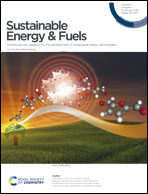Enhancing CO2 photoreduction over ZIF-based reticular materials by morphology control of Au plasmonic nanoparticles†
Abstract
Zeolitic imidazolate frameworks (ZIFs) are promising photocatalysts for CO2 reduction due to their appropriate energy band structure and crystalline properties. However, CO2 conversion is still low due to serious electron/hole recombination on these materials. In this work, the decoration of ZIF-67 with Au plasmonic nanotriangles and nanorods is studied as a strategy to improve catalytic performance during CO2 photoreduction under visible light irradiation. The introduction of Au nanoparticles on ZIF-67 based photocatalysts favors both the activity and selectivity of photocatalysts due to the injection of energetic electrons into the surface of the ZIF derived from the plasmonic response. Besides, Au nanorods promote methanol production, achieving an overall yield of 3.16 mmol gcat−1 h−1; meanwhile Au nanotriangles contribute to ethanol production, achieving an apparent quantum yield of 7.4% at 420 nm, and these yields are 35% higher in comparison with Au nanospheres. The high localized surface plasmon resonance on the edges of rod- and triangle-nanostructure favors the minimization of the recombination of electron–hole pairs during CO2 photoreduction. Therefore, our results revealed that the morphology control of Au plasmonic nanoparticles has a significant impact on the selectivity and activity of Au@ZIF-67 catalysts, which could be a starting point to develop efficient reticular materials for CO2 photoreduction.



 Please wait while we load your content...
Please wait while we load your content...